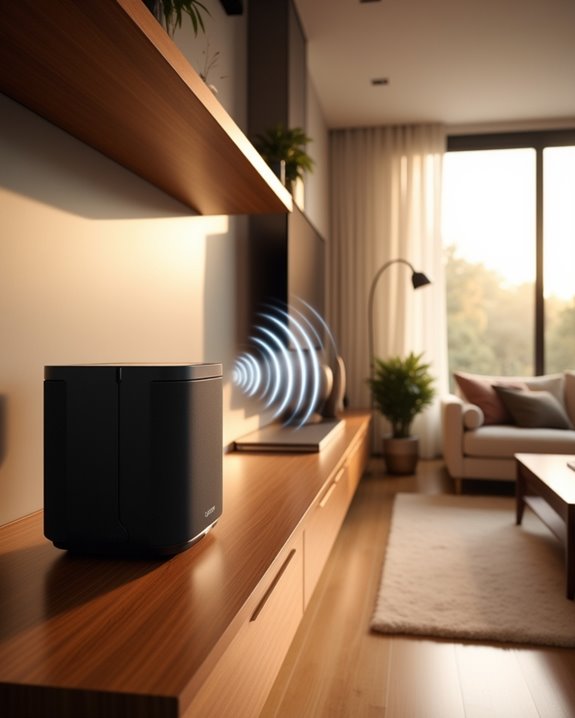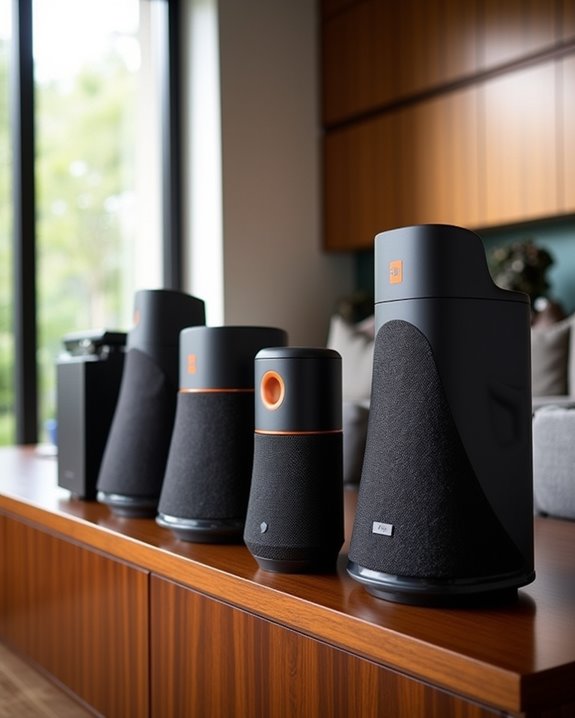Sonos transforms home audio through advanced wireless multi-room technology that enables synchronized playback with sub-millisecond precision. The system offers streamlined Wi-Fi setup, intuitive zoning capabilities, and Trueplay acoustic optimization that adapts to room dimensions. Users can create distinct audio zones while maintaining seamless audio handovers between spaces. Sonos integrates Dolby Atmos support, voice control functionality, and IP67-certified portable options. Further exploration reveals how these innovations compare to traditional audio systems costing under $4,000.
Key Takeaways
- Sonos enables synchronized multi-room audio with sub-millisecond precision across different speakers using standard WiFi networks.
- Users can create distinct audio zones that play different content in separate rooms or unified music throughout the home.
- Trueplay technology automatically tunes speakers based on room acoustics for optimized sound quality in any space.
- Setup requires only power and the Sonos S2 app, eliminating complex wiring while supporting seamless system expansion.
- Sonos integrates with smart home systems and supports voice control features while maintaining privacy through local processing.
The Evolution of Wireless Home Sound Systems
The evolution of wireless home sound systems represents a technological journey spanning more than a century of acoustic innovation. From Oliver Lodge’s groundbreaking moving-coil design in 1898 to the digital advancements of the 21st century, each development has fundamentally reshaped how people experience audio in their homes. Historical innovations in amplification technology, particularly Lee DeForest’s 1906 Audion tube, established the foundation for high-fidelity sound reproduction. The 1950s-60s witnessed the stereophonic revolution, transforming home audio into a dedicated entertainment category. By the early 2000s, Bluetooth technology enabled the first truly wireless speakers, though limited by 30-foot range and basic audio quality. Modern systems now leverage advanced codecs like aptX HD and LDAC, delivering CD-quality audio wirelessly while integrating seamlessly with smart home ecosystems, with the Sonos Five standing out as a premium example.
Creating a Multi-Room Audio Experience With Sonos

Sonos systems excel at multi-room audio through their advanced WiFi connectivity, enabling perfectly synchronized playback across multiple speakers without the signal drops common to Bluetooth devices. Users can establish distinct audio zones throughout their homes, playing different content in separate rooms or the same music everywhere, all controlled through the intuitive Sonos S2 app. This flexible zoning capability, combined with seamless room handovers as listeners move throughout the home, creates a cohesive audio environment that traditional speaker systems simply cannot match. Additionally, Sonos supports whole-house audio systems that integrate easily with various smart home devices, enhancing the overall listening experience.
Seamless Room Synchronization
When audiophiles consider transforming their living spaces into immersive sound environments, Sonos’ multi-room synchronization capabilities stand as a technological marvel in home audio systems. The brand’s approach to SyncTechnologyIssues involves sophisticated buffer management that coordinates playback across multiple speakers within sub-millisecond precision, effectively eliminating AudioDelaySolutions typically required in professional setups.
Unlike complex professional audio systems that demand specialized hardware, Sonos achieves remarkable synchronization through standard WiFi networks and proprietary algorithms. The system maintains imperceptible latency between rooms while allowing users to group or ungroup speakers dynamically through the intuitive app interface. This technical achievement permits seamless audio shifts as listeners move between spaces, creating a cohesive soundscape throughout the home. The flexibility to combine different speaker models into synchronized groups represents a significant engineering accomplishment that distinguishes Sonos in the connected home audio market.
Flexible Content Zoning
Building upon the synchronized audio environment, flexible content zoning elevates the Sonos ecosystem from mere synchronized playback to a truly customizable multi-room experience. The system allows grouping 2-16 compatible speakers into semi-permanent zones that persist even when speakers go offline, making it ideal for Corporate Zoning scenarios where distinct audio environments are needed.
Zones function as cohesive units with shared settings for room name, volume limits, and loudness, while maintaining individual speaker controls for fine-tuning. The color-coded UI in the Sonos app distinguishes between different zones, simplifying management across multiple rooms. For Event Zoning applications, administrators can utilize the chime function to identify specific speakers visually and audibly. Volume synchronization guarantees balanced audio output across all zone members, creating a cohesive listening experience regardless of speaker placement.
Simplifying Setup: From Unboxing to Streaming in Minutes

Setting up a Sonos system eliminates traditional audio configuration headaches through its streamlined Wi-Fi connection process that requires only power and the Sonos S2 app. The app intelligently guides users through speaker placement and room assignment, creating acoustically optimized zones without requiring technical expertise or complex wiring. Within minutes, listeners can expand their system across multiple rooms, creating synchronized audio environments that stream from over 100 music services through an intuitive interface that manages the entire home audio ecosystem. Additionally, the system’s compatibility with a variety of whole house speaker systems ensures flexible integration for diverse setups.
No-Hassle Wi-Fi Connection
Gone are the days when setting up audio systems required technical expertise and hours of configuration. Sonos has revolutionized the wireless audio experience through its intelligent auto-negotiation system that seamlessly connects to any modern router supporting WiFi 5/6 standards.
The app immediately detects devices upon launch, requiring minimal user intervention. When users unbox their first Sonos product, the system automatically searches for available networks and optimizes connection settings. Dual-band capability allows devices to select the ideal frequency, while SonosNet’s mesh technology enables interference reduction by creating a dedicated audio network.
For multi-speaker setups, only one device requires initial wired connection, after which the entire system synchronizes wirelessly. Password credentials need only be entered once, propagating securely across all connected units without complex router configurations or manual IP management.
App-Guided Speaker Placement
When users begin their audio journey with Sonos speakers, the intuitive app-guided placement system transforms what could be a complex technical process into an effortless experience. The Sonos application delivers precise Placement Guidance through a step-by-step interface, eliminating guesswork for ideal acoustic performance.
Following App Directives, users receive recommendations such as maintaining minimum clearance of one to two inches around speakers for superior sound diffusion and positioning paired speakers several feet apart for enhanced stereo separation. The system provides real-time feedback during setup, ensuring proper component integration throughout the process. Custom mounting solutions further optimize speaker height for immersive audio experiences. This methodical approach to speaker positioning addresses critical acoustic variables including room dimensions, furniture placement, and reflective surfaces—factors that greatly impact sound quality and ultimately create a cohesive listening environment throughout the home.
Instant Multi-Room Music
How quickly can a sophisticated audio system transform from boxed components to a fully functioning multi-room experience? With Sonos, the shift takes mere minutes through an intuitive WiFi-based setup process guided by their proprietary app. Users experience plug-and-play functionality that facilitates immediate audio deployment across multiple zones.
The system’s therapeutic applications become apparent as listeners assign customized audio environments to different rooms, creating mood-specific zones throughout the home. Creative explorations flourish when users group speakers for synchronized playback or maintain independent streams in separate areas. The WiFi connectivity eliminates cumbersome wiring, while TruePlay technology automatically calibrates each speaker for ideal acoustic performance based on room dimensions. This streamlined approach to multi-room audio supports seamless expansion, allowing new components to integrate into existing configurations without disrupting established settings.
Beyond the Basics: Advanced Features in the Sonos Ecosystem
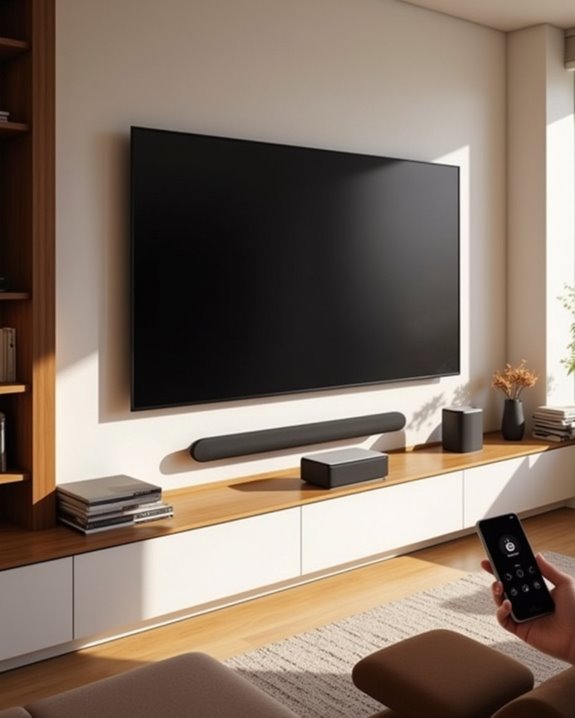
What truly elevates the Sonos experience beyond conventional audio systems is its robust suite of advanced features that seamlessly blend cutting-edge technology with user-centric design. The Sonos Arc Ultra exemplifies this with its Waveguide Upgrades for tweeters, precisely directing sound waves to create a more immersive listening field while maintaining remarkable clarity. Transducer Efficiency has been greatly enhanced through Sound Motion technology, which delivers powerful bass response without requiring a bulkier soundbar profile.
Trueplay tuning, now accessible on both iOS and Android platforms, automatically calibrates audio output based on room acoustics. Enhanced Speech Enhancement modes guarantee dialogue remains crisp and intelligible during complex audio scenes. These sophisticated features, combined with intuitive interfaces and expanded connectivity options like Wi-Fi 6, transform ordinary listening spaces into acoustically optimized environments.
Sonos for Entertainment: Enhancing Movies, Gaming, and Music
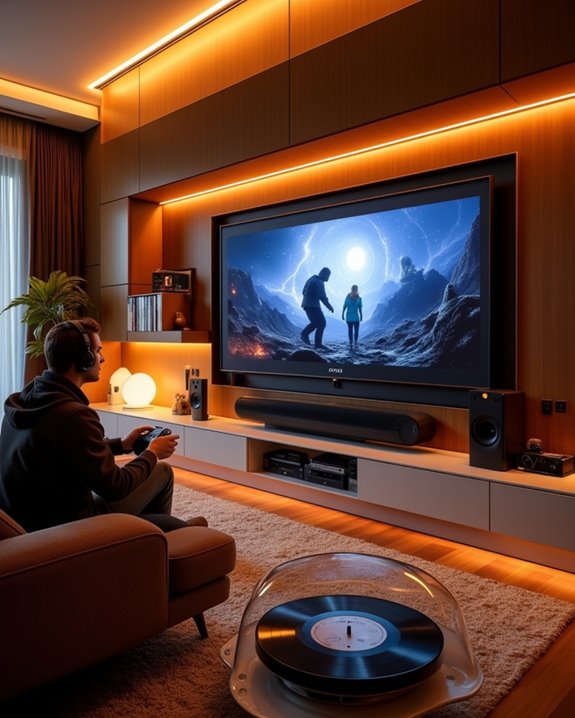
Sonos delivers cinematic sound experiences by enabling immersive Dolby Atmos and DTS:X technologies that project audio in multiple dimensions, creating an authentic home theater environment. The company’s soundbars and wireless subwoofers transform living rooms into personalized screening venues, with customizable EQ presets and Trueplay optimization ensuring acoustic precision regardless of room configuration. Gamers benefit from Sonos’ low-latency HDMI eARC connections and spatial audio reproduction, which provides critical directional cues for competitive play while eliminating cable management challenges through wireless connectivity.
Cinematic Sound Everywhere
When entertainment cravings demand superior audio quality, modern home theater systems must deliver immersive experiences that transform ordinary viewing into sensory adventures. The Sonos Arc Ultra exemplifies this Immersive Theater concept with its configuration of 14 custom drivers, including seven silk-dome tweeters and six midwoofers that reproduce frequencies with remarkable precision. Sound Motion technology creates surround effects that envelop listeners in three-dimensional audio.
This Sound Innovation extends beyond hardware specifications into intelligent adaptation systems. Trueplay tuning measures room acoustics to optimize output specifically for each unique environment, while upward-firing tweeters deliver height channels that complete the Dolby Atmos experience. Users can wirelessly connect subwoofers and surrounds for extended bass response and broader soundstage coverage without cable clutter, ensuring cinematic audio quality fills every corner of the viewing space.
Gaming Without Cables
For serious gamers, the tangle of wires typically associated with premium audio setups often creates an unwelcome distraction from immersive gameplay. While Sonos wasn’t designed specifically for cable-free gaming, its wireless configuration offers creative solutions for reducing setup complexity. Gamers can leverage Sonos speakers like the compact Ray, connecting via optical audio to maintain quality sound transmission with minimal cable presence.
For enhanced VR mobility, Sonos systems support fluid movement during gameplay without tripping over speaker wires. The system remains compatible with modern cloud streaming services, allowing gamers to switch seamlessly between gaming audio and entertainment content. Though some limitations exist—notably the requirement for optical connections that some gaming PCs lack—the Ethernet connectivity option provides a reliable, low-latency alternative for competitive gameplay scenarios.
Voice Control Capabilities and Smart Home Integration
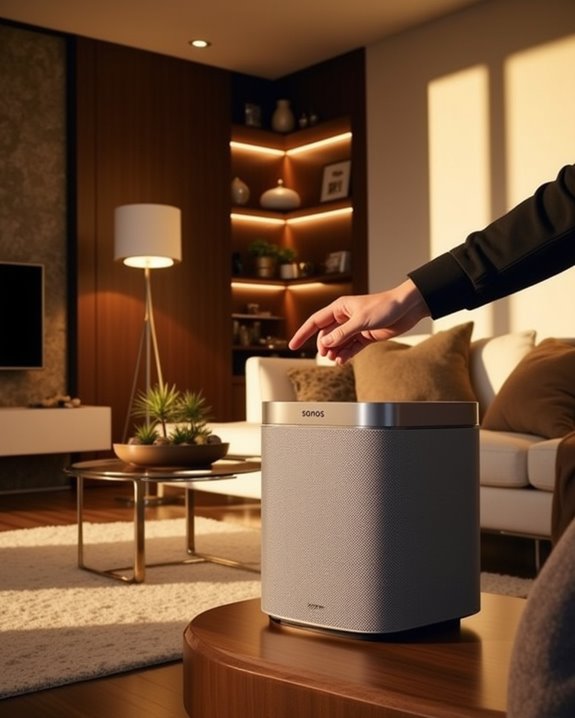
Modern voice technology transforms how users interact with their audio systems, and the Sonos ecosystem exemplifies this evolution with its sophisticated voice control architecture. The “Hey Sonos” wake phrase activates the system’s extensive playback commands without requiring physical interaction, while Privacy Features guarantee user data remains secure through local voice processing rather than cloud transmission. The absence of always-on microphones further reinforces Sonos’ commitment to privacy-conscious design.
Users benefit from Bilingual Support with both US-English and French language options, increasing accessibility across diverse households. The system intelligently coexists with third-party assistants like Alexa and Google, allowing specialized task distribution where Sonos manages audio playback while other assistants handle smart home functions. This integration enables whole-home audio steering through simple voice commands without sacrificing reliability during internet outages.
Comparing Sonos to Traditional Audio Systems
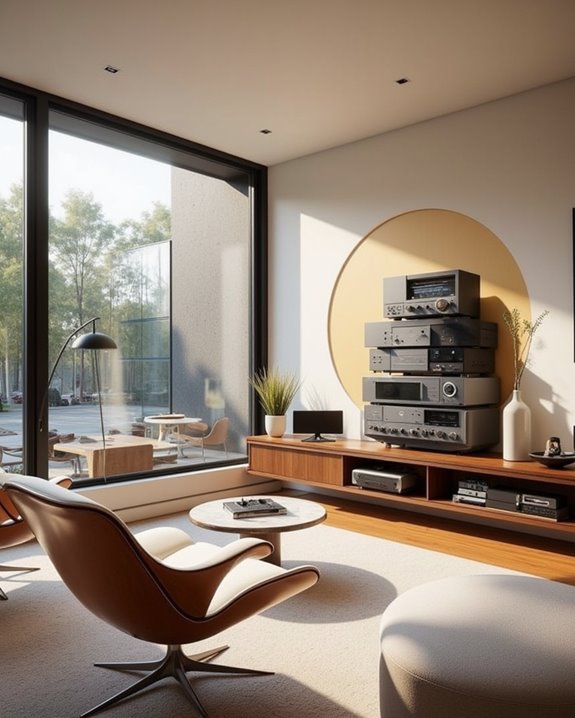
While Sonos has revolutionized audio streaming with its wireless ecosystem, traditional audio systems continue to offer distinct advantages in core performance metrics that discerning audiophiles value. Traditional setups typically deliver superior frequency response with deeper bass and crisper highs, resulting in noticeably lower sound distortion during complex audio passages.
The value proposition differs substantially between these systems. Sonos offers wireless convenience and aesthetic integration at price points under $4,000, ideal for modern living spaces where design matters. Traditional systems, though requiring more complex installation, provide component-by-component upgradeability that can reduce long-term maintenance costs. Their superior scalability allows users to replace individual elements rather than entire systems when technology advances. For smaller rooms, Sonos’s TruePlay calibration effectively optimizes sound, while larger spaces benefit from traditional systems’ true 360-degree immersion capabilities.
Portable Options: Taking the Sonos Experience Outdoors
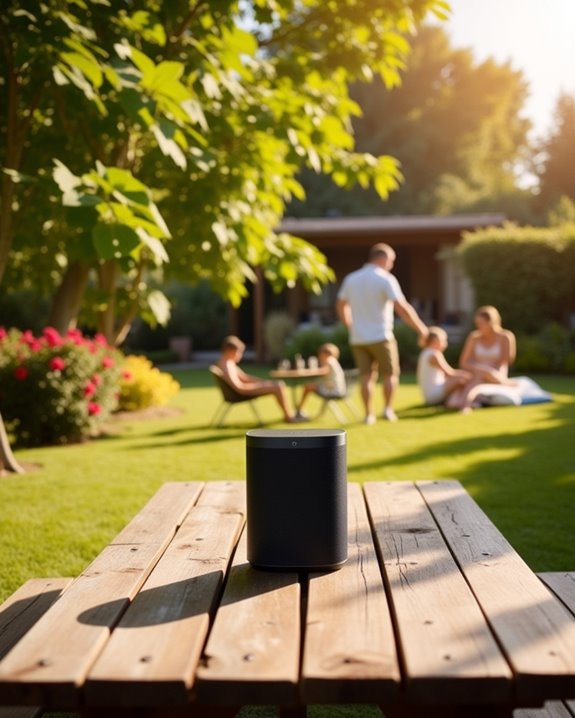
Outdoor enthusiasts seeking to extend their premium audio experience beyond living room walls now have multiple weatherproof Sonos options engineered specifically for exterior environments. The Roam 2, weighing under 1 pound with IP67 certification, represents the ultimate travel essential for poolside or camping adventures, surviving 30-minute water immersion. For larger gatherings, the Move 2 delivers all-day battery life in an IP56-rated housing with a convenient built-in handle.
Permanent installations benefit from the Outdoor Speakers by Sonos/Sonance, featuring impressive outdoor durability with IP66 protection, 6.5″ high-excursion woofers, and FastMount brackets for tool-free positioning. All portable units seamlessly integrate with indoor Sonos components through the app, enabling synchronized whole-home audio that maintains consistent quality across interior and exterior zones.
Customizing Sound Profiles for Different Spaces
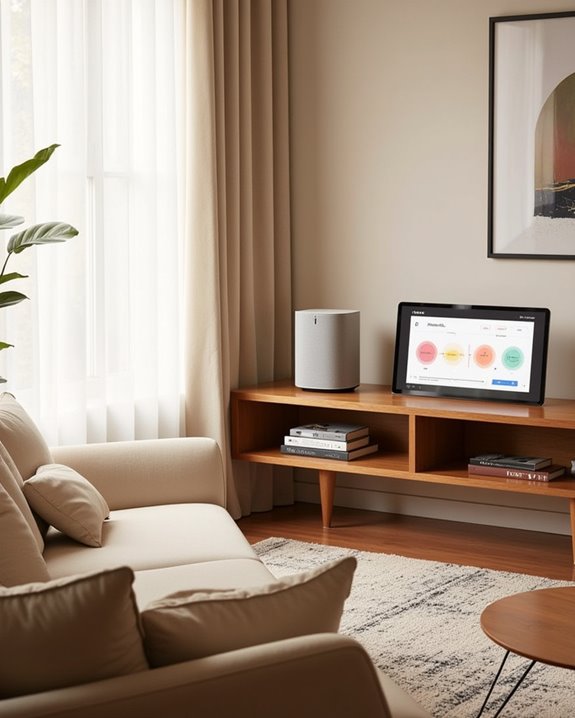
How effectively sound waves travel through a space depends greatly on room dimensions, furniture placement, and architectural features—factors Sonos addresses through its thorough acoustic calibration systems. The Trueplay tuning technology provides thorough Frequency Balancing by measuring acoustic reflections from walls and furnishings, completing the process in approximately three minutes per room.
While the system lacks formal Custom Presets, Sonos offers individualized EQ management for each speaker through dedicated bass and treble controls. Users can create personalized settings for different content types, with community members reporting ideal music profiles achieved by adjusting midrange response (+3 treble/-2 bass). The Era series leverages sophisticated spatial mapping capabilities through upward-firing drivers, making them particularly effective in spaces with high ceilings or complex architectural features that would otherwise compromise audio performance.
Future-Proofing Your Home Audio Investment
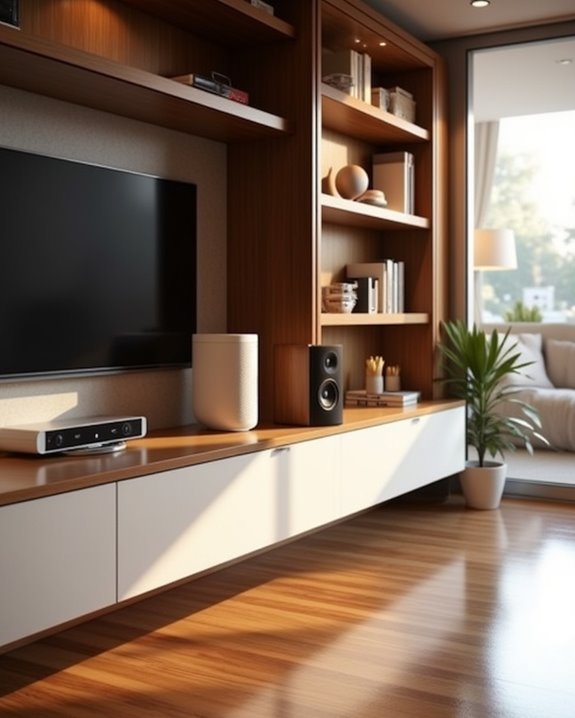
Beyond tailoring audio to specific spaces, investing in home audio systems involves considering their long-term viability in a rapidly evolving technological landscape. Sonos addresses this challenge through multiple forward-looking strategies, including hardware designed for 10+ year lifespans and regular firmware updates that enhance functionality without requiring new equipment purchases.
The company’s commitment to sustainability manifests through thorough repair options for modular components, allowing users to replace specific parts rather than entire units when failures occur. Additionally, their trade-up program provides recycling incentives that offer discounts on newer models when returning legacy devices. This approach, combined with universal connectivity standards like Bluetooth 5.1+ and WiFi 6, guarantees systems remain compatible with emerging technologies. The integration of advanced audio formats like Dolby Atmos and lossless codecs further guarantees compatibility with next-generation content delivery methods.
Frequently Asked Questions
What Happens to Sonos During Internet Outages?
During internet outages, Sonos systems can still play locally stored music but lose streaming capabilities. Outage scenarios vary in impact, with offline features limited to personal libraries on NAS drives or connected devices within the home network.
Can I Connect Older Audio Equipment to My Sonos System?
Yes, legacy integration is possible through Sonos Port or Amp. The Port connects to receivers via RCA inputs, while Amp directly powers speakers. Both solutions maintain equipment compatibility between older audio devices and modern Sonos systems.
How Does Sonos Handle High-Resolution Audio Files?
Sonos handles high-resolution audio files by supporting FLAC format up to 24-bit/48kHz resolution. While this exceeds CD quality, users with higher resolution formats must downsample files to enjoy improved audio quality within Sonos’ technical limitations.
Are Sonos Speakers Repairable or Only Replaceable?
Contrary to repair myths, Sonos speakers lack authorized repair options and typically require full replacement. Users seeking warranty tips should note that DIY repairs void coverage, though community forums offer unofficial fixes for those comfortable with self-service solutions.
What’s the Typical Lifespan of Sonos Products?
Sonos products typically last 5-10 years, exceeding standard warranty periods. With proper maintenance, many devices function well beyond this timeframe, though technological obsolescence rates may eventually impact compatibility with newer systems and features.

